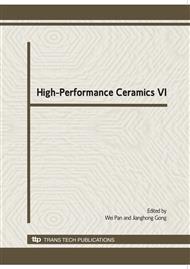p.304
p.307
p.311
p.314
p.318
p.324
p.328
p.331
p.335
Microstructure and Electrical Properties of Bi3+ Modified ZnO Ceramics
Abstract:
High-quality bismuth modified zinc oxide ceramics were obtained by conventional ceramic method. The phase analysis revealed pure hexagonal ZnO phase in all the samples. High relative density (above 95%), when compared with theoretical density of ZnO, was achieved by the Arquimides’ method. Non-linear coefficients, obtained from the J-E curves, shown an increase in their values as the bismuth content increases. Complex impedance analysis revealed an increase of the semicircle diameters with the increase of the bismuth content. The obtained results will be discussed within the framework of the current theoretical model proposed in the literature.
Info:
Periodical:
Pages:
318-223
Citation:
Online since:
March 2010
Authors:
Keywords:
Price:
Сopyright:
© 2010 Trans Tech Publications Ltd. All Rights Reserved
Share:
Citation:


